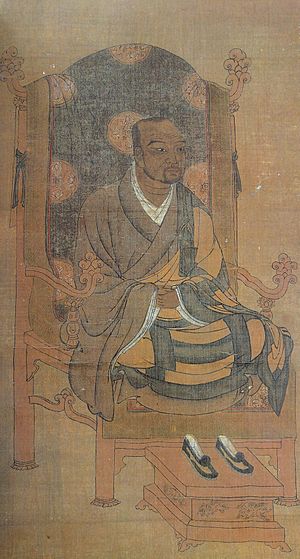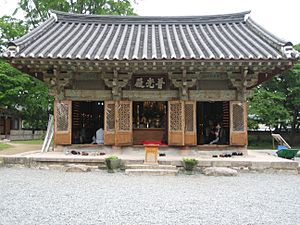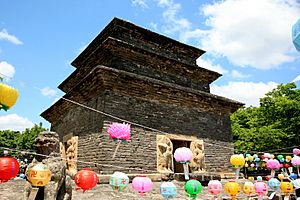Wonhyo facts for kids
Quick facts for kids Wonhyo |
|
|---|---|
 |
|
| Religion | Buddhism |
| Korean name | |
| Hangul |
원효
|
| Hanja |
元曉
|
| Revised Romanization | Wonhyo |
| McCune–Reischauer | Wŏnhyo |
| Birth name | |
| Hangul |
설사
|
| Hanja |
薛思
|
| Revised Romanization | Seol Sa |
| McCune–Reischauer | Sŏl Sa |
| Courtesy name | |
| Hangul |
서당 or 신당
|
| Hanja |
誓幢 or 新幢
|
| Revised Romanization | Seodang or Sindang |
| McCune–Reischauer | Sŏdang or Sindang |
Wonhyo (617 – 686) was a very important thinker and writer in East Asian Buddhism. He was one of the most famous scholars in Korean Buddhism. Wonhyo wrote over 80 books, which were widely read. His ideas helped shape Buddhism in Korea, China, and Japan.
His most famous writings explained ideas like buddha-nature and the Awakening of Faith. These books became classics. Many famous Buddhist teachers in China and Japan were influenced by Wonhyo's teachings.
Contents
Who Was Wonhyo?

Wonhyo was born in a place called Amnyang (now Gyeongsan, South Korea). He started his journey as a monk, learning from different Buddhist teachers. He spent time studying at Hwangnyongsa Temple.
Wonhyo's Big Realization
One famous story about Wonhyo tells how he planned to travel to China. He wanted to study more about Buddhist teachings there. In 661, Wonhyo and his friend Uisang were on their way to China.
They got caught in a heavy rainstorm. They found shelter in what they thought was a small cave. During the night, Wonhyo was very thirsty. He found a gourd and drank some cool, refreshing water.
The next morning, they woke up to a surprise. Their "cave" was actually an old tomb! The "gourd" was a human skull, and the "refreshing water" was dirty, old water.
This experience changed Wonhyo's life. He realized that his mind had made the dirty water seem refreshing. He understood that our minds can change how we see reality. This deep insight taught him that everything we experience comes from our own mind. Because of this, he felt he didn't need to go to China anymore. He had found the truth within himself.
Life After the Priesthood
After this experience, Wonhyo decided to leave the traditional monk's life. He wanted to share Buddhist teachings with everyone, not just scholars. He called himself a "Layman of Minor Lineage."
Wonhyo was known for his unusual ways. He would visit towns and villages, singing and dancing to teach Buddhist ideas. He also spent time with ordinary people, even visiting bars and sleeping in their homes. While this was not typical for a monk, people saw it as a clever way to help everyone understand Buddhism. He also spent time alone in the mountains, writing and teaching people to chant the Buddha's name.
Wonhyo became a popular hero in Korea. He later had a son named Seol Chong, who became a famous scholar. Wonhyo passed away in 686 at the age of 70. His son buried him at Bunhwangsa Temple.
How Wonhyo Influenced Others
Wonhyo's work had a huge impact across East Asia. His writings were highly respected by Buddhist scholars in Korea, China, and Japan. He wrote many books, and even today, some are still being translated into English.
Wonhyo was especially good at making sense of many different Buddhist texts. He showed how they all shared a single, deeper truth. He believed that all teachings could work together. His ideas helped create the important Hwaeom school of Buddhism in Korea.
Wonhyo is also thought to have founded Silleuksa, a famous temple by a river. Because of his strong connection to Bunhwangsa, there is a special research center and shrine there dedicated to him.
Wonhyo's Main Ideas
Wonhyo lived during a time of big changes in Korea. His work was very important for spreading Mahayana Buddhism in the country. He was a central figure in how Korean Buddhism grew.
Wonhyo studied many different Buddhist ideas. He wrote about Buddha-nature, East Asian Yogācāra, and Huayan thought. His writings are still quoted by scholars today.
He didn't stick to just one Buddhist group. He used ideas from many different traditions to create a unified Buddhist philosophy. Most of his writings were commentaries, which are explanations of classic Buddhist texts.
Making Different Ideas Agree
One of Wonhyo's main goals was to show how different Buddhist teachings were not actually in conflict. He called this "harmonization of disputes" (hwajaeng). He believed that all Buddhist teachings were based on one deep principle.
Wonhyo would look closely at why different Buddhist ideas seemed to disagree. He often found that these differences came from how people understood words or from their own viewpoints. He thought that if you looked past the words, you could see the shared meaning.
He didn't try to rank Buddhist teachings from best to worst. Instead, he showed how they were all connected and worked together. Wonhyo believed that all Buddhist teachings were like different paths leading to the same truth. He said that trying to divide the Buddha's teachings too strictly was like trying to scoop out the ocean with a snail shell.
Wonhyo explained his "Hwajaeng theory" in his book Ten Approaches to the Reconciliation of Doctrinal Disputes. He taught that problems often arise when people take words too literally. He wrote: "If you take a sentence literally, it could be disagreed with. If you focus on its meaning, you could understand it."
For Wonhyo, all Mahayana Buddhist teachings were like metaphors pointing to the same ultimate truth. He also used the idea of "interpenetration" from Huayan Buddhism. This means that all Buddhist ideas are connected and don't block each other. He even called his philosophy "interpenetrated Buddhism."
The Idea of One Mind
Wonhyo's philosophy also focused on the "One Mind theory." This idea says that the "One Mind" is the ultimate reality. It has two parts:
- True-thusness: This is the pure, unchanging truth, the real nature of the mind. It's beyond thoughts or differences.
- Arising-and-ceasing: This is the everyday mind, which is always changing and affected by causes and effects. It's the mind that experiences suffering and delusion.
So, the One Mind is the single source of everything. It includes both the pure truth and the changing world of everyday life. This idea comes from a famous book called The Mahayana Awakening of Faith. Wonhyo wrote many commentaries on this book.
Another important idea for Wonhyo was "essence-function." Here, "essence" is the pure truth (the One Mind), and "function" is all the changing things we see in the world. Wonhyo believed these two parts were not separate but were part of a single, harmonious whole.
Finding Your Own Enlightenment
Wonhyo also wrote about "original enlightenment." This idea says that enlightenment is already inside our minds. We just need to discover it by clearing our minds and practicing good deeds. For Wonhyo, the ultimate truth, the One Mind, is enlightenment itself, and it is present in everyone.
He taught that to become free and enlightened, we need to truly understand that everything is the One Mind. This One Mind is already within us. So, enlightenment isn't about gaining something new. It's about recognizing what is already there. It's like "returning to the original source."
How do we get there? Wonhyo said it happens through "actualizing enlightenment." As we practice Buddhism, we move away from ignorance. The original enlightenment slowly reveals itself as we get rid of bad habits and confused thoughts.
Wonhyo believed these deep ideas could be used in daily life. He taught both ordinary people and important leaders. For common people, he often taught simple practices, like chanting the name of Amitābha Buddha with a sincere heart.
Wonhyo's Writings
Wonhyo was a very productive writer. He wrote about 80 books, and 22 of them still exist today. He wrote more than almost any other single scholar in East Asian Buddhist history.
His books covered all the main Buddhist topics of his time. Most of his writings were detailed explanations of classic Buddhist works. He tried to show how every part of a text connected to the rest. He also showed how each text fit into the larger picture of all Buddhist teachings. He wanted to prove that all of Mahayana Buddhism could be understood through a single text.
Some of his important books include:
- Doctrinal Essentials of the Great Perfection of Wisdom Sūtra
- Doctrinal Essentials of the Lotus Sutra
- Expository Notes to the Awakening of Mahāyāna Faith
- Praise of Amitabhaʼs Realization of His Nature
- Exposition of the Vajrasamādhi-sūtra
- Doctrinal Essentials of the Nirvana Sutra
Today, Wonhyo's existing books are being translated into English. This is a big project involving universities in Korea and the United States.
Wonhyo's Legacy
Wonhyo's name is still remembered today in many ways.
- The International Taekwon-Do Federation has a pattern (a set of movements) called "Won-Hyo." It has 28 movements.
- The World Taekwondo Federation also has a pattern called "Ilyeo" for high-level black belts. This name refers to Wonhyo's idea of "One Mind."
- The Wonhyo Bridge in Seoul, Korea, which crosses the Han River, is named after him.
Wonhyo Pilgrimage Project
In 2011, a Canadian journalist named Tony MacGregor walked across the Korean Peninsula. He wanted to understand Wonhyo's journey and enlightenment. Legend says Wonhyo found enlightenment in a cave on the western side of the peninsula. MacGregor's walk was the first in over 1,000 years to honor Wonhyo's achievement. A documentary film was made about his journey, and there are plans to create a permanent walking trail in Wonhyo's honor.
Images for kids
See also
 In Spanish: Wonhyo para niños
In Spanish: Wonhyo para niños





